Modeling of enterprise assets: modern standards and practice

Can I enter the same river twice?
This article is based on the results of a report at the Neftegazstandart 2016 conference, which I made on behalf of TriniData Company.
Working as an ontologist engineer, I am creating information models for information systems.
')
In this article I want to talk about the practice of applying the ISO 15926 standard to modeling the assets of an enterprise, and what results this has led us to in the end. Those who are unfamiliar with the standard may not be upset - reading the article will be useful, regardless of the knowledge of the standard.
Asset modeling issues
- Building an enterprise asset model is still a difficult and non-trivial task. In my opinion, this complexity is due to the gap between modeling techniques and ordinary human thinking. For example, neither in the logic of Aristotle nor in the logic you will find anything similar to the term "instance". However, programmers and analysts very often use this word without bothering to explain its meaning. Personally, I have never found the definition of this term.
- One of the most successful asset modeling techniques is the ISO 15926 standard. It makes a revolutionary assumption that you can use time as a fourth coordinate along with ordinary spatial coordinates to model an enterprise. This approach allowed the simulation of the full life cycle of assets. However, with the help of this standard, it was not yet possible to create a universal metamodel for describing the activities of an enterprise. Actually the creators of this standard did not set themselves this task.
- A number of standards have been proposed for modeling enterprise activities, for example, the ArchiMate standard. According to the statements of its developers, this standard is friendly to the ISO 15926 standard and the TOGAF enterprise architecture modeling methodology. Despite the stated capabilities, this standard is not fully cope with the tasks. One of the reasons for this is the lack of distinction between the notions of “activity” and “activity” (activity implies purposeful efforts to achieve a result. Activity is interpreted as an event that is independent of the subject’s will). To better understand the difficulty that arises, remember how the ancient Greeks interpreted "a" in the square? They did not think it otherwise than the area of a square with sides of length a. The same can be said about the cube - the volume of the cube with sides of length “a” was recorded as “a” in the cube. But, since it is impossible to invent a physical analogue of "a" in the fourth degree, the equations above are cubic in ancient Greece were not considered. And so it was until, in the Middle Ages, algebraists did not tear off equations from physical meaning. The beginning of the era of pure mathematics was not looking for physical analogs of equations. Exactly the same thing happens in business analysis. Consideration of what is happening from only one angle of view (as an activity) severely limits our analytical capabilities.
- The ISO 15926 standard also contains a valuable opportunity to model objects of different types (for example, functional and physical), as well as the intersection of these objects in time. However, the set of possible types of objects is strictly defined by the standard, and in some practical cases it is not enough to create a model that adequately reflects the idea of an object, event, or process. For example, in the standard there are no objects of the type “production resource”.
Formulation of the problem
My last work was related to the Samara Oil Tank Equipment Plant .
The customer wanted to create an information system that would help the sales manager to interact with the client in the most efficient way. To do this, the manager must be provided with all the necessary information, which includes:
- Functional requirements model (what does the customer need?)
- Models of possible solutions (how can functional requirements be met?)
- Model of the cost of order fulfillment
- Risk model
- Customer Relationship Model
To solve the task, it was actually necessary to create a model of the entire enterprise, starting from the asset model, ending with the activity model.
The ISO 15926 standard was taken as the ideological basis for creating the model.

The standard perfectly copes with the task of describing the life cycle of assets, modeling functional and physical objects, as well as their intersection. However, to create a full-fledged enterprise model, the capabilities of this standard were not enough.
To describe the activities of the company could take the ArchiMate notation.
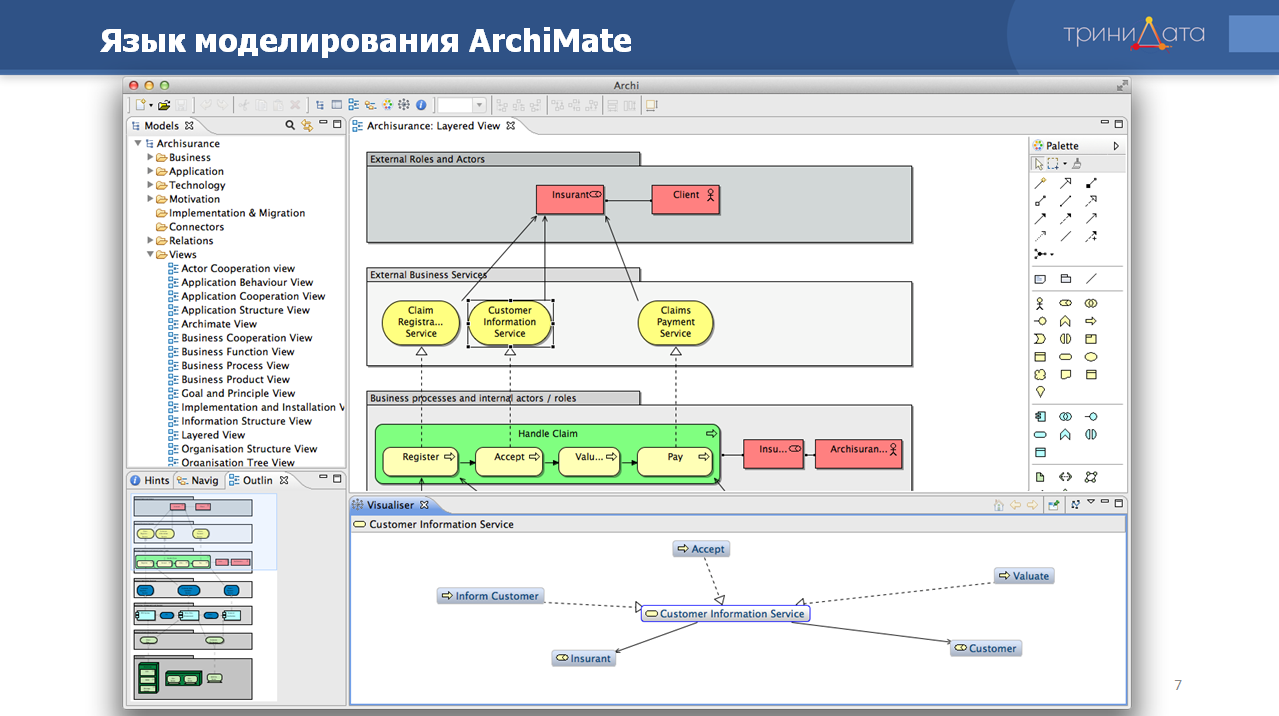
But it did not fit for the reasons stated earlier - there is no differentiation between the activity model and the activity model. In addition, it does not contain an accurate description of what a business function is, as it is related to operations and processes. To solve this problem in the standard it would be necessary to separate the two meanings of the same question: “Is this one and the same object?” In the sense of the same object? or is it similar objects? Unfortunately, the standard does not distinguish between these two different values of this question, so there is no possibility to build a model of activity correctly: two business operations are recognized as one object in the sense of being similar to each other, but two business functions are recognized as one object if they are really match up. It is impossible to confuse these issues in one model.
Then we continued to work independently on creating a model of activity. In the process of this work, we were surprised to find a single template that allows us to model not only activities, but also costs, functional and physical objects. Moreover, the method of modeling these entities turned out to be universal. This method could be used anywhere!
Next, I will talk about this method in more detail.
Decision
A new concept that we need is a point of view. Consider a pump as an example of an asset.
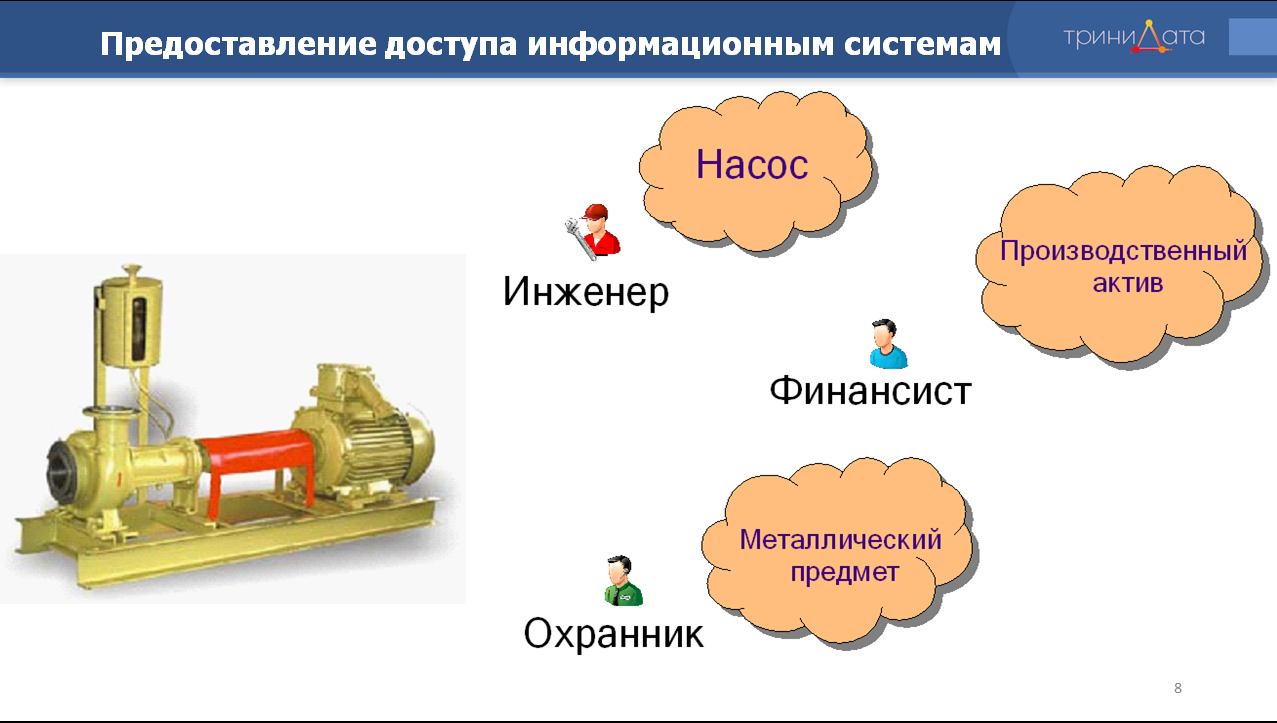
From the point of view of an engineer, this is a functional object, from the point of view of an accountant or economist, it is a production asset. The way a person perceives an object depends on the business function in which the subject who is building the model participates. Therefore, we introduce the concept of “point of view” and talk about the interpretation of an object within a certain point of view. For example, the fact that this item is interpreted by the engineer involved in the operation of the pipeline as a pump, interpreted by a financier involved in budget approval is interpreted as a production asset, and by an enterprise security officer as a tangible object that must be protected from theft, depends on the point of view of the object.

The second concept we need is a construction. Consider the construction of the human body.
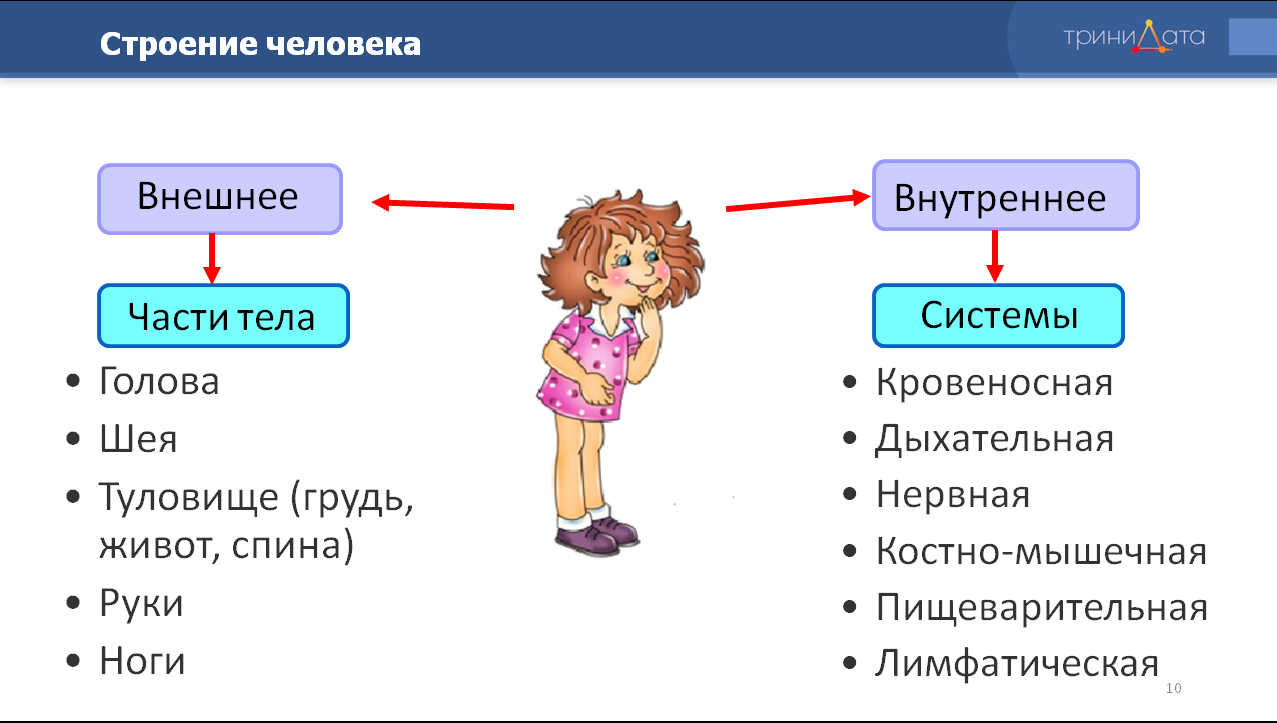
We know at least two different points of view. From one point of view, the body consists of arms, legs, torso and head. From another point of view - from the musculoskeletal system, nervous, circulatory, respiratory and digestive systems. You can think of and imagine many other ways of representing the human body as a structure. What is true for the human body is also true for assets. Consider, for example, a rig.

Depending on the function in which the subject participates, he will see its different construction.
One will see many units, and the other - many subsystems. Moreover, such partitions can be done arbitrarily much.
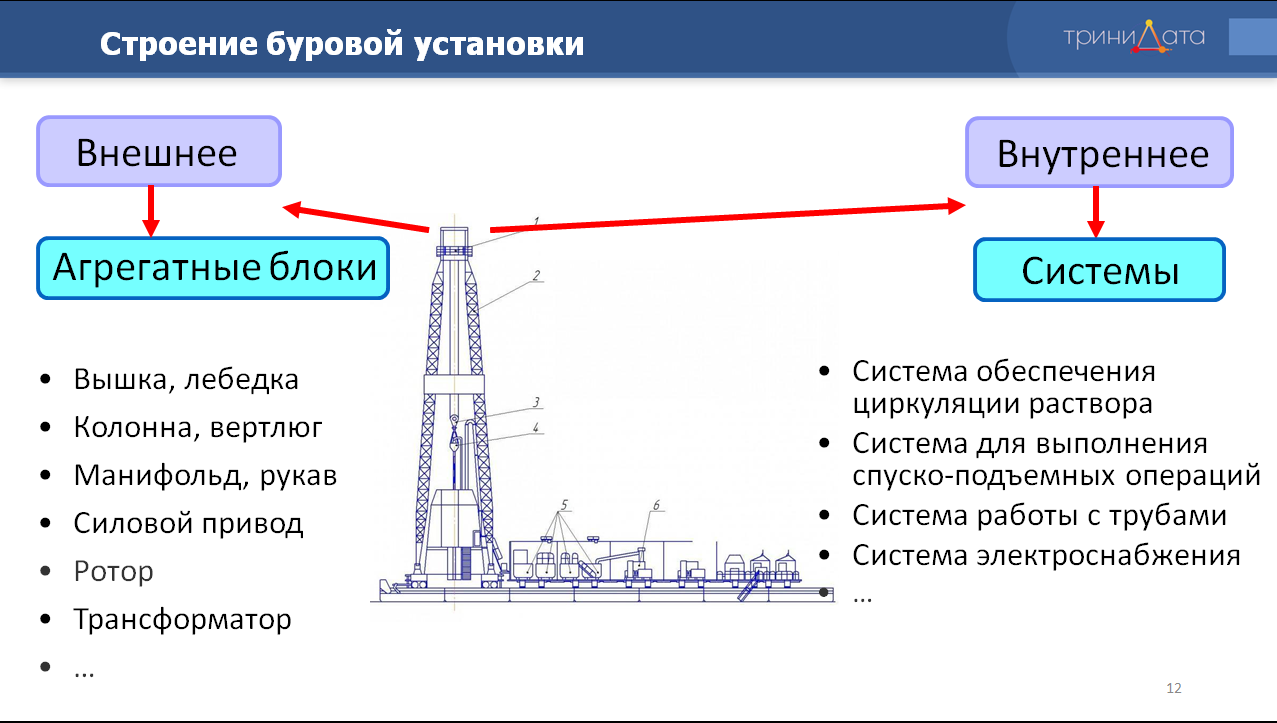
To simulate such a diversity of the concept of "design" we need along with the concept of "object".

Looking at the results, we concluded that there are no physical and functional objects. There are many areas of human activity, each of which generates its own point of view and its own models. You can make models based on each such point of view, and describe the matrix of transitions from one model to another. The way it is done in ISO 15926:
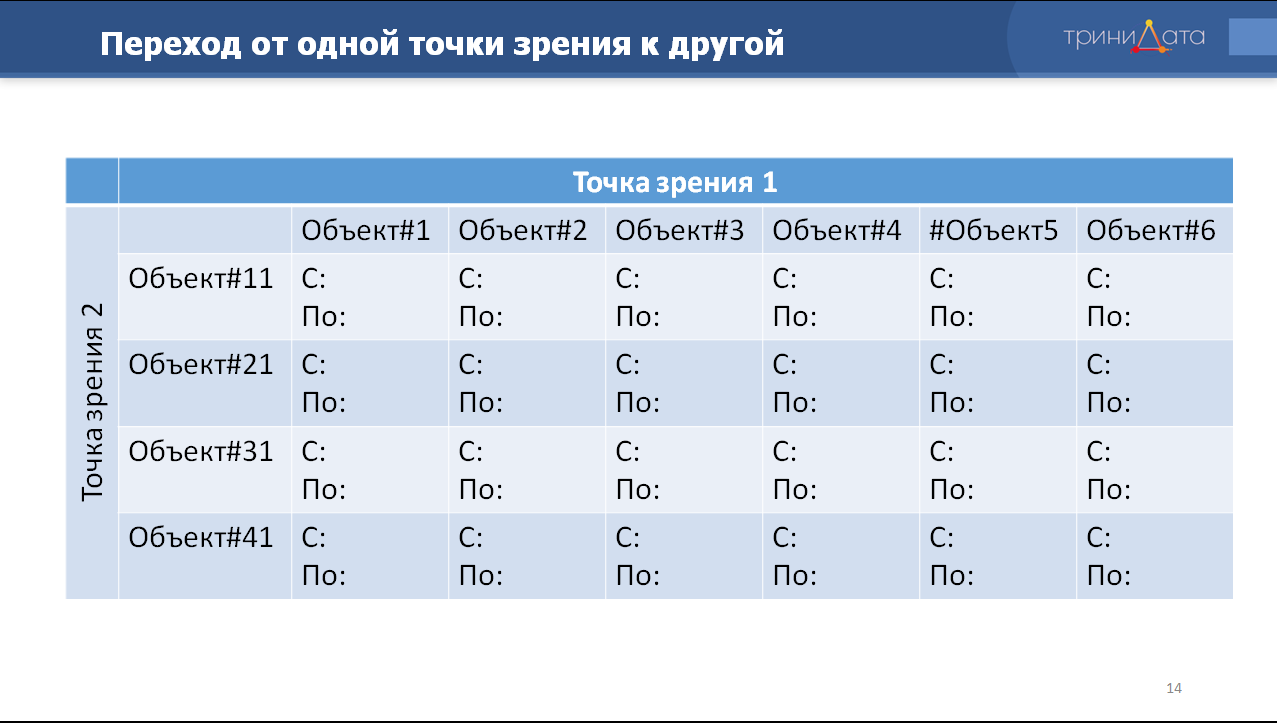
After that, you can move from one view to another, changing points of view. This allows you to store information about models created by different people with different goals in one information repository.
ISO 15926 describes a method for building a data warehouse in which only two points of view are taken into account: the point of view of the physical world and the point of view of functional objects. It also describes how to go from one view to another through temporal parts. That is, you can get an answer to the question: what physical objects played the role of this functional and when? You can get an answer to the opposite question: what functional objects did one or another physical object perform? The answer to these questions is the way to move from one view to another. However, by introducing the concept of "point of view" we are no longer limited to only two points of view. Now we can create as many points of view as we need for our modeling purposes.
The maximum benefit from such an approach to modeling can be obtained by considering the activity of the enterprise itself as an object having a design.
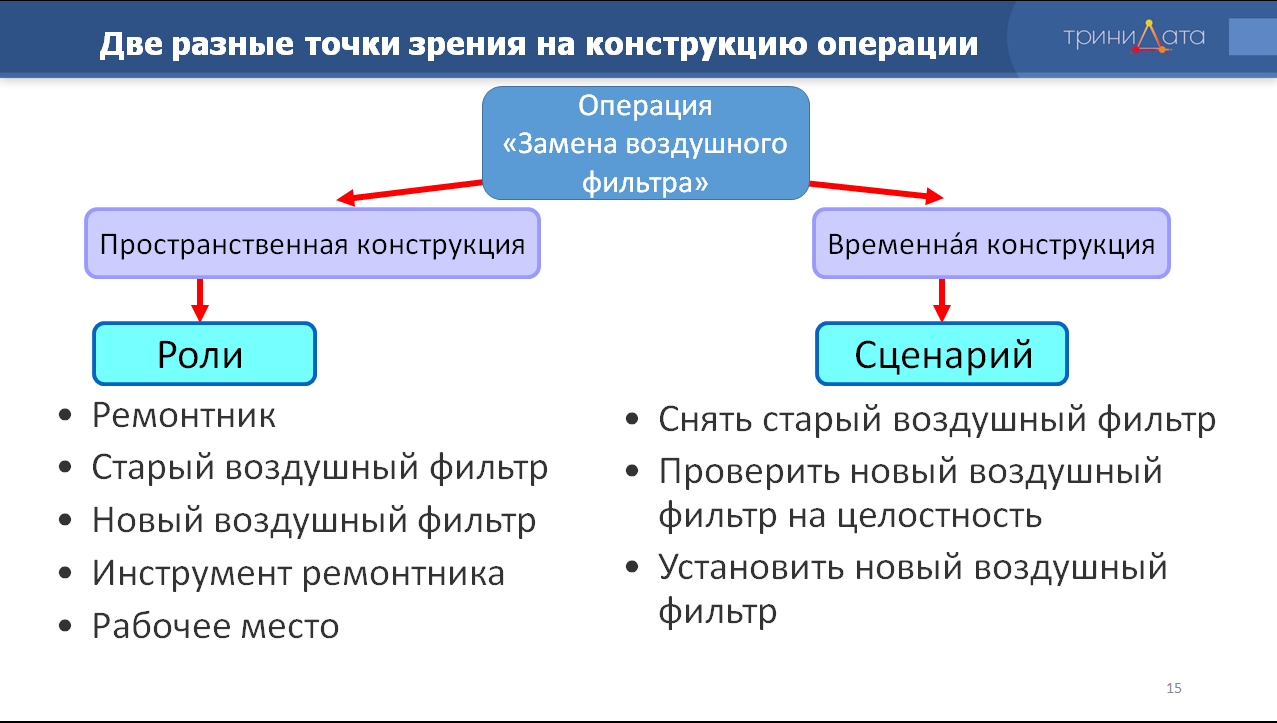
From one point of view, the construction of an operation can be represented spatially as a set of roles, and on the other hand, temporally as a set of suboperations - a scenario.
Thus, the framework for describing the architecture of an enterprise is based on concepts: point of view, object and design. This allows you to create information models that do not require structural rework during operation. For example, you can create an information model in which you can move from one point of view to another - for example, from supplier to customer, without forcing them to take a single, common point of view on each object.
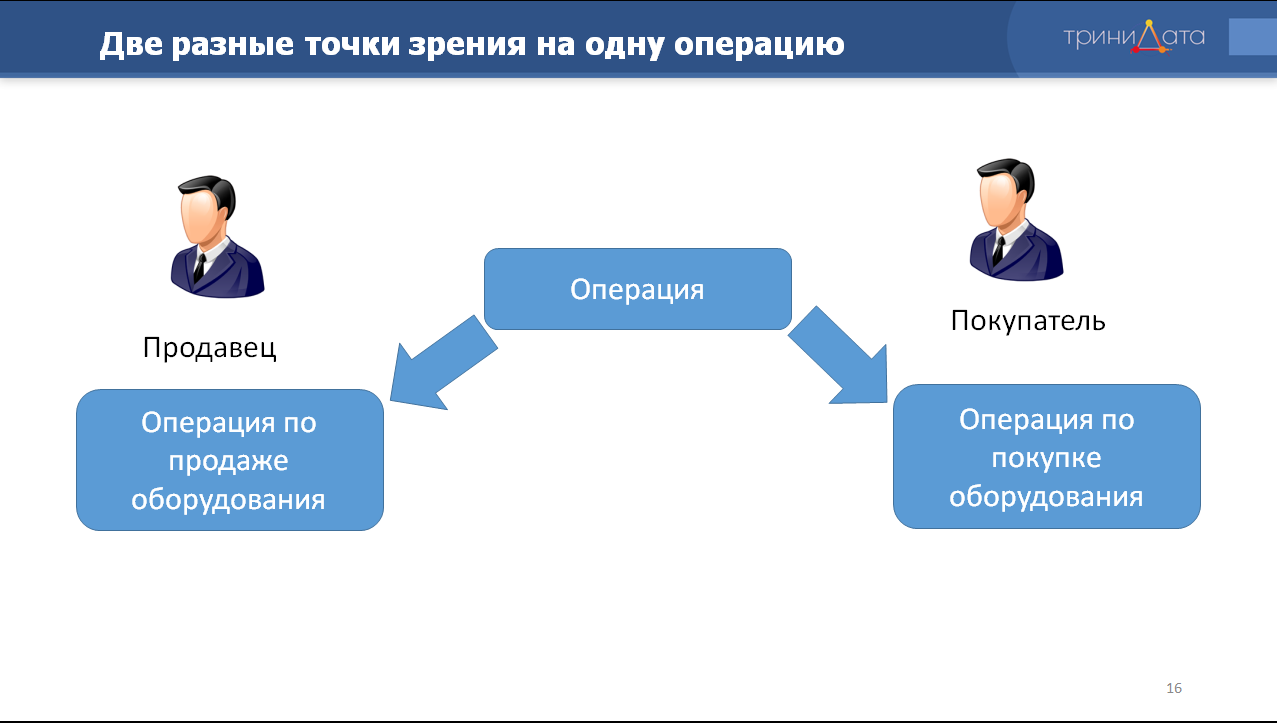
So, the same operation from the point of view of the supplier is called "sale", and from the point of view of the client - "purchase". By the way, the ability to move around the model, changing points of view, allows us to solve the problem of pass-through accounting (traceability).
Behind the frame of our conversation, let's leave consideration of more complex accounting units: sets, types, attributes. To complete the asset description framework, you must carefully consider these objects.
Results:
The resulting metamodel has the following advantages:
- Metamodel is close to our natural thinking, which allows, if necessary, to easily expand it, for example, by introducing probabilities into it.
- Metamodel has versatility. We could describe everything that we needed to model using this method.
- An additional bonus was the possibility of describing different types of activities in one framework. For example, ordinary production activities and activities to sabotage production activities are described in a single way in one model.
- We were able to break the link between the model and the methodology for its application. The developer of the model is no longer required to know the goals with which one or another model will be applied. He fixes the facts, and other subjects are involved in their interpretation. This allows you to create models with the required level of secrecy.
- Metamodel assumes such a point of view on the subject area, which does not require the introduction of predefined types of objects: for example, functional or physical. Similar types are entered as needed and the number of such types can be any.
- Metamodel allows you to move from one representation of an object to another of its representation, using one information model.
- Metamodel allows you to create an information model that can expand indefinitely. Its expansion is limited only by the amount of stored information, but not by logical contradictions that could arise due to inconsistency of data.
Difficulties in implementing the model:
- The difficulty in implementing this model is that the resulting model has a greater degree of complexity and therefore places high demands on the software implementation.
- To create models of this level of complexity requires additional training of specialists.
Source: https://habr.com/ru/post/313936/
All Articles